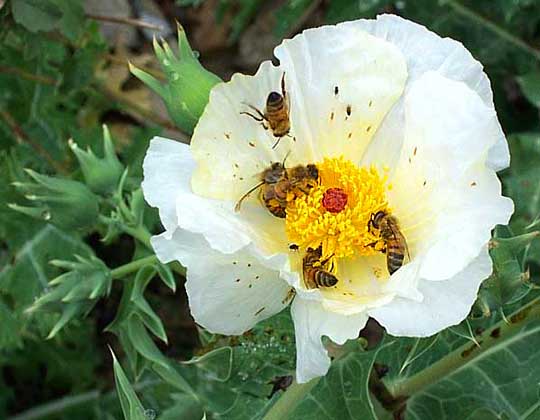Excerpts from Jim Conrad's
Naturalist Newsletter
from the January 5, 2007 Newsletter issued from Sierra Gorda Biosphere Reserve, QUERÉTARO, MÉXICO
PRICKLY-POPPIES
Though the scrubforest -- except for the Sweet Acacia -- looks subdued in its crispy, scratchy, dry-season way, people's gardens and certain weedy areas continue to flourish. One common weed putting on a show now with its four-inch-wide, white flowers is a Prickly-poppy, genus ARGEMONE. I'm not sure which species it is*. All of ours are white-flowered and you can see one, with honeybees harvesting pollen from its yellow stamens, below:

In that picture you can see why it's called prickly. Each leaf-lobe ends in a sharp spine, plus the flower's calyx is spiny. The four roundish, spiny objects to the blossom's left are not fruits, but rather unopened flower buds with each scale -- the future sepal -- bearing a stiff, broad-based spine.
Prickly-poppies are members of the Poppy Family, which is easy enough to believe not only because the flowers look like poppy flowers but also because if you wound the plant it exudes orange latex. Remember that opium is made from dried latex exuded by scratched poppy fruits.
It's not surprising, then, that traditionally Prickly- poppies have been regarded as having special medicinal properties. My Las Plantas Medicinales de México provides a recipe for making an alcohol-based extract from fresh fruits meant to induce sleep and calm a cough. The Aztecs used the latex as an eye medicine, to clear their vision of spots and clouds.